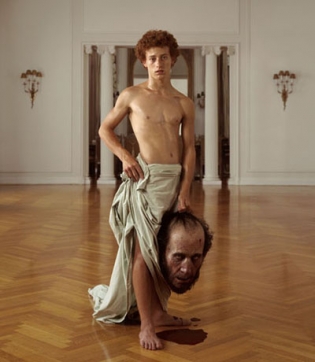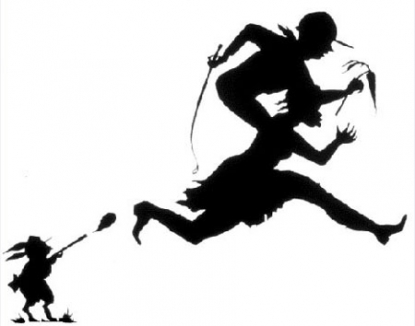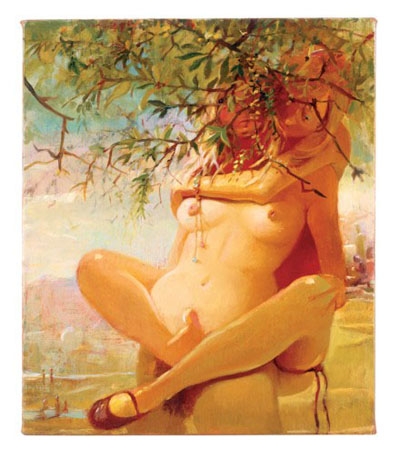Feature: Reviews
Administrativism and Its Discontents
Mark Van Proyen’s monograph, Administrativism and Its Discontents, Art Criticism (vol. 21, no. 2) is a complex, bewildering, bombastic, and at times, pretentious work. The author is, at once, waging total war (with shock and awe) on major art institutions, slashing and burning his way along the road we are on; He obviously feels we’ve been going the wrong way. He is angrily cleansing the temple of, not so much moneychangers, but arts administrators. In fact, in tone it sounds like a piece of hate mail that goes beyond mere “anti-postmodern pessimism” by attempting to formulate a larger theory of the state of the post-modern art world and how it got there.
Van Proyen looks at art from the late 1980s through the early 2000s, labeling the dominant strain, “Art Administrator Art.” His focus is primarily on large art institutions, museums, art fairs, and biennials where he feels art administrators (including directors and curators, celebrity or otherwise) exhibit works which will re-enforce their hegemonic positions as certifiers of art (not enduring art, but more fashion and entertainment), squashers of subjectivity (“murderers of the author;” Van Proyen wants “intentionality” to matter again) and marketers, catering particularly to their own “corporate paymasters” and the cultural tourist. Art Administrator Art (what most call post-modern: conceptual, installation, multi-media, video, too big for a domestic setting) is contrasted with art which embodies meaning based on the crystallizing, synthesizing, and idealizing of the personal experience of the artist. The power of the latter is its ability to trigger a cathartic experience, “...provid[ing] the actual moments of dangerous ecstasy to which it might allude.” This visionary art with its “will-to-what-might-be” could “prompt a viewer into a condition of greater courage, greater wisdom, or greater empathy.” All of which Art Administrator Art does not do.
Van Proyen goes on to describe the ethos underlying the work of art administrators, labeled as “schizoid administrativism” or in another context as “adminidoxy.” This “ethos” serves to empower and maintain the superior positions of art administrators with artists, their works, critics and now the art market itself (whose former power has been usurped), all dependent on institutional patronage and used to support administrative structures. Schizoid Administrativism became particularly manifest during the Culture Wars at the end of the 1980s and into the 1990s and when “identity politics” and its attendant “political correctness” were superseded by an emphasis on “New Globalism” and the digital divide, a move sensitive to changing corporate interests. Currently, Van Proyen wonders why there is no upheaval in the arts, no outrage over the Iraqi War and other conditions. He lays the blame at the feet of art administrators who want distance and affectlessness in their art and do not value “...the poetic attributes of authenticity, mastery, integration, and containment…” (p. 37) With Art Administrator Art, we are left with mere “simulations of experience.”
Critics do not escape Van Proyen’s scathing scorn for they are complicit in the interpretation and promotion of Art Administrator Art, particularly the October gang (which values only art that fits their neo-Marxist/Lacanian orthodoxy). Others receive partial dismissal, for instance Arthur Danto (only a pseudo-pluralist when he excludes the Neo-Expressionists), Jed Perl (perceptive but doesn’t go far enough; a philistine), Dave Hickey (rightly critical of art institutions, but has no real metaphysics of art) and so on. I actually found this chapter the most convincing and interesting, but do not all critics (including Van Proyen) value the art that fits their "orthodoxy" no matter how unarticulated.
Finally, we get to what happens next. What does “post-administrativism” art look like? Van Proyen provides hope by looking to two strands, one is the work, labeled “mannerist surrealism,” of Lisa Yuskavage, Kara Walker, and Charlie White, and another is the total work of art (Gesamtkunstwerk,) represented by Matthew Barney and Burning Man. The irony of his choices is that (setting Burning Man aside) all of these artists are shown in large art institutions and their work is in prominent collections, private and institutional. Some art administrators must be doing something right, though you would never know it from reading this monograph.
As a critique, several points need to be made.
Covering the same period as Van Proyen, Johanna Drucker, in her book Sweet Dreams: Contemporary Art and Complicity (University of Chicago Press, 2005), fosters a very different take on contemporary art. She recontextualizes this art as engaging material and mass culture in an exploratory, playful manner rejecting Modernism’s critical vocabulary and the idea of the avant garde as an oppositional and negative force. She writes: "I love the art of the 1990s and 2000s [which she sees as embodying ‘complicit formalism’] because it seems fresh, exuberant, vibrant, and eclectic in its capacity to imagine ways of producing meaning through formal invention." (p. xiii) Drucker blames critical writing with its negative vocabulary of the "abject," the "subversive," the "transgressive," the "resistant" as being too rigidified to encompass the true meaning and formal qualities of contemporary art. To Drucker, art’s claim to moral superiority, above mass culture and its interest in money and success, is hypocritical and untenable.
She continues:
"Form making, fracture, the structure and iconography of images, means of production, circumstances of making and reception, critical and technical training, as well as underlying assumptions—- all of these are facets of complicity, of the embedded condition of meaning and effect accessed through response to formal properties…. Complicit formalism counters the very basis on which autonomy could be assumed, while returning respect for the aesthetic properties of works of art—- material and visual considerations—- to a central place within our understanding of the ways art works through constructed artifice." (p. xvi)
What Van Proyen sees as Art Administrator Art in a negative light, Drucker sees as “complicit formalism” in a positive one, a point to be seriously considered, rather than summarily dismissed.
Further, does Van Proyen fall within Drucker’s negative critics? Yes and no. The negativity is there, but the same reasoning is not. In his book Psychoanalytic Theory of Art: A Philosophy of Art on Developmental Principles (Columbia University Press, 1983), Richard Kuhns makes the point that “countertransference” can be taken outside of the clinical setting. For him, like Van Proyen though not in those words, “countertransference” refers “to a response of the viewer to the peculiar ties of the object in terms of associations and interpretations that the viewer’s unconscious thought provides.” (p. 88) Drucker is neither negative nor concerned with affective response, focusing more on formal means.
Kuhns goes on to indicate that art-historical approaches (and here he is referring to the Wittkowers/older art-historical approach with its themes, styles, documentation and so on) do not consider “the realm of strong affect, the kinds of feelings we have with works of art that are immediate responses to the objects and that no amount of historical reference can explain.” (p. 88) Likewise, psychoanalytic approaches do not consider or link affective responses to larger cultural (anthropological) contexts or sociological histories. As Kuhns has put it, “Freud’s [and his followers’] generalizations lack the sensitive differentiations that cross-cultural study requires.” (p. 47) It is important to remember that art administrators generally have backgrounds and training in art history and therefore are not naturally prone to consider psychoanalytic approaches to evaluating art or particularly to value merely affective works.
For an artist and writer who is hailing art that fosters greater empathy, Van Proyen certainly misses the mark (so to speak), particularly when considering the lives of directors and curators of large institutions and the compromises many feel forced to make. His polemic sounds like a sweeping personal attack, not a reasoned argument. John Searle, in an article “What is Institution? [originally printed in The Journal of Institutional Economics (June 2005); reprinted in Institutional Critique and After, edited by John C. Welchman (2006)] writes:
“The essential role of human institutions and the purpose of having institutions is not to constrain people as such but, rather, to create new sorts of power relationships. Human institutions are, above all, enabling, because they create power, but it is a special kind of power. It is the power that is marked by such terms as: rights, duties, obligations, authorizations, permissions, empowerments, requirements, and certifications.” (p. 34)
"…[I]nstitutional structures create desire-independent reasons for action. To recognize something as a duty, an obligation, or a requirement is already to recognize that you have a reason for doing it which is independent of your inclinations at the moment. (p.35)"
It is obvious that Van Proyen does not like these power relationships, seeing art administrators as too willing to protect their positions by currying favor with corporations and cultural tourists. But, art shown at large institutions is necessarily limited by the purposes of these institutions and the requirement that administrators protect and defend, not so much their positions (many have lost theirs in the last few decades) as their institutions, irrespective of what their personal inclinations might be. What Van Proyen sees as schizoid might just be ambivalence. Ultimately, the relationship between institutions and artists is an interdependent one. Despite what Van Proyen says, artists do have power, and many even have integrity, and can move within and through these institutions creating affective works which embody their experience, but also needing to consider larger historical shifts and events.
Many people feel a shift happening or about to happen in art, away from postmodernism (Robert Storr comes particularly to mind,) but few have attempted to declare its direction. Van Proyen is brave to do so, but defies the political truism of our time in attempting to make change by dividing instead of unifying. I’ve got to say it: Make love, not war.
(2) COMMENTS
In answer to Steven Barich’s question about dates, Mark’s monograph was published in 2006. I think in the Fall 2006, and I couldn’t get a copy of it until 2007. I wrote my review in May 2008, and it was posted on Stretcher in August 2008.
My problem with Mark’s analysis is that it is so slash and burn and doesn’t discuss alternatives. It is an example of “creative destruction”, I suppose, which must be very cathartic for Mark and others, but what value is it other than that? My background is art history. So the Church, royalty, the bourgeois art market of the galleries and large art institutions (founded by individuals tied to larger corporate interests as they have always been: Rockefellers and the NYMOMA, JP Morgan/others? and the Met etc) have been “barriers/opportunities” for artists in history. But, so what?
Further, Mark and his ilk never discuss alternative art spaces and alternative galleries as “certifiers of art.” These organizations/institutions have been very influential. The fact that personal/social relationships are so important points to a couple of ideas. One, there are many artists who are “damn good” so sometimes the decision to show one versus another, due to the limited space, is based on personal knowledge/relationship. Second, I have noticed that many curators here just exhibit artists they are familiar with/who are in their circle and whose work they have seen over years, possibly. I have curated shows and always include a call for submissions. Not only do I include people I know, but I am always searching for those I do not. I do not assume I have seen the best work there is. I urge other curators to be open to looking at unfamiliar work. Sometimes, the trouble here in San Francisco is that we see the same work and individuals over and over again.




This article by Fortunati is a great review. I would like to know when it was drafted/published (there is not date here at Stretcher…or I just overlooked it).
Let me state that I have yet to read Van Proyen’s book, however, I have been a fan of his writing in ArtWeek for many years. Van Proyen always struck me as courageous in his willingness to buck the trend(s) in art and art critique by going after styles and themes that have dominated local SF Bay Area institutions exhibition calendars (the Mission School as a style for example, BAN and SECA as value/judgement). I am not against these institutional-bred awards and styles myself, but having a critical voice in our local art scene that asks you to redefine your own views by laying out a usually well worded critique is, and always will be, welcome in my view.
So, while myself a fan of Van Proyen, I am also a fan of Dave Hickey, and it is surprising that Van Proyen would stick it to Hickey (because I think they actually have some views in common). I obviously will have to read the book to see if it is entirely true about Hickey, but I can guess that Van Proyen would also have appreciated (in his career so far…) the invitation to curate exhibitions and receive the spotlight, like Hickey, in order that he could “put his money were his mouth is” and maybe re-direct the institutions (and therefore the administrators) that he so rails against. Instead, he did what he could: he took his opinions to print.
And, I do think that Van Proyen has an undeniable point: based on this reviews analysis, that art institutions and the administrators of these institutions have a gross influence on art and the artists of todays society - in order to “succeed” on an regional, national and/or international level, artists must “fit” the institutional bill of one moment or another (which is why in the nineties so many “outsider” artists, who had been active for decades, finally were exhibited in large institutions…why? Because to be an outsider was hip in the nineties, and it might still be…). As an artist myself, one that has studied in the Bay Area and also liveded in Western Europe for many years, I have seen first hand how relationships with art administrators on a personal/social level is just as important to an art career as any artist’s artwork is. Administrators do have a responsibility in representing their institutions because it is their day job, but responsibility and power and the mixing of the professional and the personal allows administrators to promote their own agendas, and because institutions have money and status and advertisement, this can so easily override what is happening with art down at the street level, which is sometimes exponentially more interesting than what the upper echelon art institution has to offer. Please don’t get me wrong and paint my reaction as anti-establishment: I’m just honest about much administrators “hegemonic positions as certifiers of art” does work in the real world international art scene. And then again, this is why we have galleries, so that the gallerists can show us and tell us what they think is the hottest of the hot shit regarding art (and entertainment and fashion).
Maybe all I wish to say then is this: Van Proyen holds high “...the poetic attributes of authenticity, mastery, integration, and containment…” (p. 37), which is admirable, because that is what is still taught in the art schools and what continues to romantically inspire artists of every generation… unfortunately, it often works out that if you don’t get blessed by an institutional exhibition, an artist can rarely make a career out of simply being a damn good draftsperson, painter or sculptor on their own.
Steven Barich • October 03, 2008